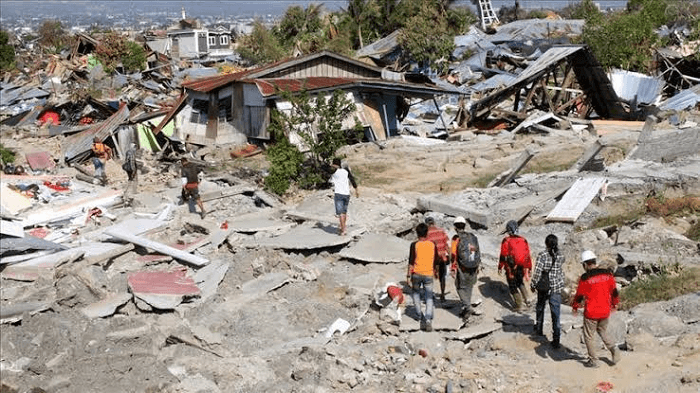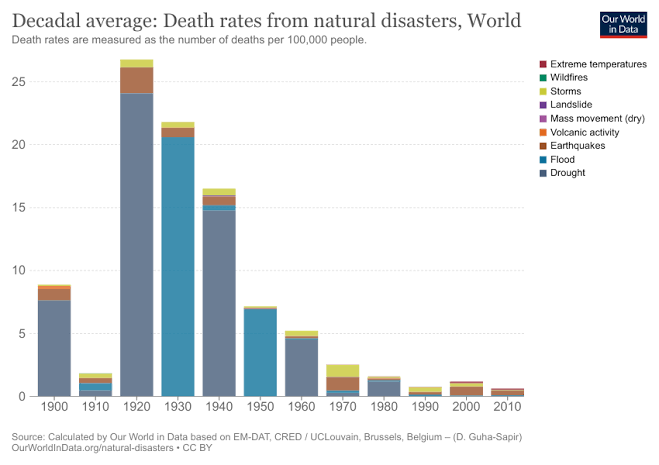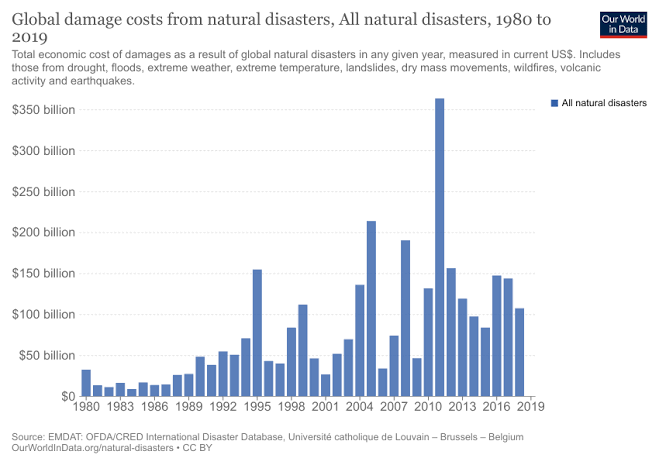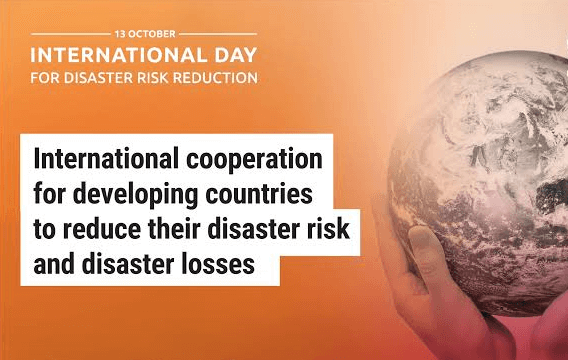Natural Disasters EssayThe term "disaster" is defined as follows: Disasters are serious disruptions to the functioning of a community that exceeds its capacity to cope using its own resources. Disasters can be caused by natural, man-made, and technological hazards As well as various factors that influence the exposure and vulnerability of a community. - International Federation of Red Cross and Red Crescent Societies (IFRC) "The adverse effect accompanying an actual occurrence of a natural hazard in the event that it considerably hurts a community" is what is meant by "natural disaster." A natural disaster usually leaves behind some economic harm in addition to the potential for loss of life or property damage. The resilience of the affected population and the state of the infrastructure determine how severe the damage will be. Avalanches, coastal flooding, cold waves, droughts, earthquakes, hailstorms, heat waves, hurricanes (tropical cyclones), landslides, lightning, riverine flooding, high winds, tornadoes, tsunamis, volcanic activity, wildfires, and winter weather are a few examples of natural hazards. 
It can be challenging to distinguish between man-made, natural, and man-accelerated disasters in the modern period. Architecture, fire, resource management, and even climate change are all examples of human decisions and actions that may contribute to "natural disasters". In reality, it was declared in 1976 that the phrase "natural disaster" is a misnomer. A disaster occurs when a risk, whether natural or artificial, affects a community that is already at risk. A disaster is the outcome of a hazard combined with the vulnerability of a civilisation that is weak. 
Inadequate building codes, discrimination against some groups, injustices, resource overuse, extreme urban development, and climate change can all make natural catastrophes worse. The world's population is expanding quickly, and this increased density-often in risky environments-has increased both the frequency and severity of disasters. The unstable landforms and tropical climate, along with deforestation and unplanned growth proliferation, increase the vulnerability of disaster-prone places. Developing nations have more or less recurring natural disasters as a result of poor communication and insufficient funding for disaster management and prevention. If a negative occurrence takes place in a place where there aren't any susceptible people, it won't qualify as a disaster. However, in a region that is susceptible, such as Nepal, after the 2015 earthquake, an unfavourable event can have disastrous effects and leave permanent damage that can take years to heal. The terrible effects also have an impact on the communities who are touched, frequently resulting in post-traumatic disorders. Collective processing can support these more frequent emotional experiences, fostering resilience and raising community involvement. Different Types of Natural DisastersThere are numerous natural disasters that are caused for different reasons and have different effects on humans and the environment. Though these days, many natural disasters are happening due to climate change due to anthropogenic activities, some natural disasters are purely natural, with no human control over them. These natural disasters are classified as follows- Disasters Brought on by Geological Risks
An abundance of slope-forming elements, such as rock, soil, artificial fill, or a mix of these, move outward and downhill in a landslide. Avalanches caused between 40,000 and 80,000 deaths of soldiers during the mountain warfare in the Alps along the Austrian-Italian front during World War I. Artillery fire caused a lot of avalanches.
Seismic waves are produced when there is a sudden release of energy in the Earth's crust. Earthquakes cause vibration, shaking, and occasionally ground displacement at the Earth's surface. Geological fault slippage is what causes earthquakes. Seismic focus refers to the earthquake's subsurface point of genesis. The epicentre is the location that is immediately above the concentration on the surface. People and animals are typically killed by secondary events such as building collapses, fires, tsunamis, and volcanic eruptions rather than by earthquakes themselves. Better planning, safety measures, early warning systems, and construction might potentially prevent many of them.
The ground can collapse and create a sinkhole when it becomes too weak to support the buildings placed on it due to natural erosion, human mining, or underground excavation. For instance, the 2010 sinkhole in Guatemala City, which claimed the lives of fifteen people, was brought on when Tropical Storm Agatha's strong rains were channelled by leaking pipes into a bedrock made of pumice, causing the unexpected collapse of the ground beneath an industrial building.
Numerous factors can contribute to a volcano's enormous devastation and ensuing calamity. The volcanic eruption itself can be dangerous because of the force of the explosion and the potential for falling rocks to inflict damage. Lava may also be produced after a volcano eruption; due to its intense heat, as it exits the volcano, it can damage structures, vegetation, and animals. Additionally, volcanic ash has the potential to form a cloud (often after cooling) and settle thickly in the area. This turns into a substance resembling concrete when combined with water. Ash can be so heavy that it can bring roofs crashing down if there is enough of it. Because it has the consistency of powdered glass and tears the throat and lungs, even little amounts of it can be harmful to humans if inhaled. Additionally, moving machinery, such as engines, can sustain abrasion damage from volcanic ash. Pyroclastic flows, which are composed of a cloud of hot ash that accumulates in the air above the volcano and rushes down the slopes when the explosion can no longer support the lifting of the gases, are the greatest cause of death for people in the immediate vicinity of a volcanic eruption. It is thought that a pyroclastic flow was what ultimately destroyed Pompeii. A lahar is a mudflow or landslide caused by volcanoes. A lahar was responsible for the 1953 Tangiwai catastrophe as well as the 1985 Armero tragedy, which submerged the town of Armero and resulted in an estimated 23,000 fatalities. Disasters Brought on by Water Risks
A flood is when water overflows and "submerges" land. According to the EU Floods Directive, a flood is brief flooding of normally dry terrain. The word can also be used to refer to the inflow of the tides in the sense of "flowing water." When the volume of a body of water, like a river or lake, is higher than normal and some of the water escapes its normal borders, flooding may follow. A flood is not notable unless it covers territory utilised by humans, such as a village, city, or other inhabited region, highways, or large areas of farmland, even though the size of a lake or other body of water will vary with seasonal fluctuations in precipitation and snow melt.
A tsunami often referred to as a seismic sea wave or tidal wave, is a succession of waves that occur in a body of water when a substantial volume of water is displaced, most often in an ocean or a sizable lake. Undersea earthquakes, like the one that occurred on Boxing Day in 2004, landslides, like the one that occurred in 1958 in Lituya Bay, Alaska, or volcanic eruptions, like the historic eruption of Santorini, can all result in tsunamis. A tsunami struck the area around Fukushima, Japan, on March 11, 2011, and it swept over the Pacific Ocean.
A limnic eruption, often referred to as a lake overturn, happens when a gas, typically CO2, unexpectedly emerges from deep lake water, creating the risk of smothering humans, animals, and other creatures. As the rising gas displaces water, an eruption like this could also result in tsunamis in the lake. Landslides, explosions, or volcanic activity, according to scientists, might cause such an eruption. Only two limnic eruptions have been seen and documented thus far. Thirty-seven locals were killed by a limnic eruption in Lake Monoun, Cameroon, in 1984. At adjacent Lake Nyos, a considerably larger eruption killed between 1,700 and 1,800 people by asphyxiation in 1986. Disasters Brought on by Severe Weather Risks
A heat wave is a period of exceptionally high temperatures. The 2003 European Heat Wave was the worst heat wave in recent memory. In Victoria, Australia, a summer heat wave generated the conditions that fueled the devastating bushfires in 2009. Melbourne saw three consecutive days with temperatures above 40 °C (104 °F), while other outlying areas were scorched by temperatures even higher. Arsonists were partially to blame for the bushfires that were generally referred to as "Black Saturday." Over 2,000 people died as a result of the severe heat waves that plagued the Northern Hemisphere in 2010. Hundreds of wildfires were started by the heat, which resulted in significant air pollution and destroyed thousands of square kilometres of forest.
When there is a sustained period of rainfall that is much below average, the earth becomes unusually dry. Drought conditions can also be caused by hot, dry winds, a lack of water, high temperatures, and the subsequent evaporation of precipitation from the ground. Crop failure and water shortages are consequences of droughts. The 1997-2009 Millennium Drought in Australia, which caused a water supply crisis in parts of the nation, is one of the more well-known historical droughts. As a result, numerous new desalination facilities were constructed. Texas had huge economic losses in 2011 and spent the entire year under drought and unexpected crisis. The drought triggered the Bastrop flames.
A dust storm, often known as a sandstorm, is a typical meteorological occurrence in areas that are dry and semi-dry. When a gust front or other powerful wind pushes loose sand and dirt from a dry surface, dust storms are created. Saltation and suspension, a process that transfers soil from one location to another, are used to transport fine particles.
A firestorm is a blaze that has intensified to the point that it can support its own wind system. Most often, it is a natural phenomena that has been produced by some of the biggest bushfires and wildfires. A fire with its own storm-force winds from every direction towards the storm's core, where the air is heated and subsequently ascends, is what defines the phenomenon, despite the fact that the phrase has been used to describe several enormous flames.
Large burns known as "wildfires" frequently begin in wilderness areas. Lightning and drought are frequent causes of wildfires, although carelessness or intentional flames can also spark them. They pose a risk to wildlife, people, and property when they expand to populated areas. The 1871 Peshtigo Fire in the United States, which claimed at least 1700 lives, and the 2009 Victorian bushfires in Australia are two notable examples of wildfires.
The same phenomenon-a tropical storm that develops over water-goes by the titles typhoon, cyclone, cyclonic storm, and hurricane. Strong winds, copious amounts of rain, and thunderstorms define it. Where the storm originates is the deciding factor in whatever term is chosen. Storms are referred to as "hurricanes" in the Atlantic and Northeast Pacific, "typhoons" in the Northwest Pacific, and "cyclones" in the South Pacific and the Indian Ocean.
Lightning can be produced by powerful storms, dust clouds, and volcanic eruptions. In addition to the regular storm damage from winds, hail, and flooding, the lightning itself can also cause damage to structures, start fires, and result in direct fatalities. Lightning strikes have been particularly fatal, killing 30 people in Ushari Dara, a lonely mountain community in northwest Pakistan, 91 people in the disaster of LANSA Flight 508, and 469 people in a gasoline explosion in Dronka, Egypt, in 1994. The majority of lightning-related fatalities take place in the less developed nations of the Americas and Asia, where lightning is frequent, and adobe mud brick housing offers minimal protection.
A cumulonimbus cloud or, in rare instances, the base of a cumulus cloud comes into contact with the surface of the Earth to form a violent and deadly rotating column of air known as a tornado. It is sometimes known as a twister or cyclone, while the term "cyclone" in meteorology refers to any confined low-pressure circulation in a broader meaning. Although they can be of many different sizes and configurations, tornadoes usually resemble a visible condensation funnel, the narrow end of which contacts the ground and is frequently surrounded by a cloud of dust and debris. Cold-Weather Circumstances
High winds and heavy snowfall characterise severe winter storms known as blizzards. A ground blizzard occurs when strong winds stir up snow that has already fallen. Blizzards can have an effect on neighbourhood economic activity, particularly in areas where snowfall is infrequent. The United States was impacted by the Great Blizzard of 1888, which ruined tonnes of wheat crops. The two deadliest blizzards ever recorded in Asia occurred in 1972 in Iran and 2008 in Afghanistan; in the former, a region the size of Wisconsin was completely covered in snow. The 1993 Superstorm, which erupted in the Gulf of Mexico and moved north, killed more than 300 people and damaged 26 American states as well as Canada.
Ice-based precipitation that does not dissolve before it reaches the ground is referred to as hail. Hailstones typically have a diameter of between 5 and 150 mm (1/4 and 6 in). On July 12, 1984, a particularly bad hailstorm struck Munich, Germany, leading to insurance claims totalling over $2 billion.
A specific kind of winter storm called an ice storm is characterised by freezing rain. An ice storm, according to the U.S. National Weather Service, is one that leaves at least 14 inches (6.35 mm) of ice on exposed surfaces.
A cold wave is a type of weather event that is defined by a cooling of the air. It is also referred to as a cold snap or cold spell in some areas. According to the U.S. National Weather Service, a cold wave is specifically defined as a sharp drop in temperature over the course of 24 hours that significantly increases the need for protection for economic, social, and industrial activities. The pace of temperature decline and the minimum temperature reached during a cold wave determine the exact definition of a cold wave. Depending on the location and season, this minimum temperature may vary. General Impacts
A natural catastrophe may result in the loss of life, harm to the body or other health effects, destruction of property, loss of livelihoods and services, disruption of the social and economic system, or harm to the environment. Each year, thousands of people are killed by a variety of natural disasters, costing billions of dollars in damage to habitat and property, including earthquakes, landslides, volcanic eruptions, floods, hurricanes, tornadoes, blizzards, and pandemics. However, both the frequency and severity of disasters have increased due to the world's population's rapid growth and growing concentration in risky locations. The tropical climate, unstable landforms, deforestation, unplanned population growth, and non-engineered buildings increase the vulnerability of disaster-prone areas. Natural disasters strike developing countries on a more or less regular basis, owing to ineffective communication and insufficient budgetary allocation for disaster prevention and management. Impact On The EnvironmentMore waste may be produced during emergency situations such as natural disasters and military conflicts, but waste management is a significantly lowered priority in comparison to other services. Existing waste management services and infrastructures may be disrupted, resulting in unmanaged waste and increased littering in communities. Human health and the environment are frequently harmed under these conditions. Natural disasters (for example, earthquakes, tsunamis, and hurricanes) have the potential to generate a large amount of waste in a short period of time. Waste management systems can become inoperable or limited, necessitating significant time and money to restore. For example, the tsunami in Japan in 2011 generated massive amounts of debris, with the Japanese Ministry of the Environment reporting estimates of 5 million tonnes of waste. In late 2011, some of this waste, mostly plastic and styrofoam, washed up on the coasts of Canada and the United States. This boosted the amount of litter by a factor of ten along the west coast of the United States and may have transported alien species. Storms are also significant sources of plastic litter. Lo et al. (2020) discovered a 100 per cent increase in the number of microplastics on Hong Kong beaches after a typhoon in 2018. During disaster relief operations, a significant amount of plastic waste can be generated. Following the 2010 earthquake in Haiti, the waste generated by relief operations was dubbed a "second disaster." Although there was no operational waste management system, the US military reported that millions of water bottles and styrofoam food packages were distributed. For emergency shelters, over 700,000 plastic tarpaulins and 100,000 tents were required. The rise in plastic waste, combined with poor disposal practices, resulted in the obstruction of open drainage channels, increasing the risk of disease. Conflicts can result in large-scale community displacement. People living in these conditions are frequently provided with only the most basic waste management facilities. Burn pits are commonly used to dispose of mixed waste, which includes plastics. Air pollution can cause respiratory and other health problems. For nearly 45 years, Sahrawi refugees have been housed in five camps near Tindouf, Algeria. Plastics have flooded the streets and surroundings of the camps because waste collection services are underfunded, and there is no recycling facility. In contrast, the Azraq camp in Jordan for Syrian refugees has waste management services; 15 per cent of the 20.7 tonnes of waste produced per day is recyclable. International Campaigns
The United Nations launched the International Early Warning Programme in 2000 to address the root causes of vulnerability and to build disaster-resilient communities by raising awareness of the importance of disaster risk reduction as an integral component of sustainable development, with the goal of reducing human, economic, and environmental losses due to hazards of all types. The International Day for Disaster Reduction (IDDR) is a global event that encourages all citizens and governments to work together to build more disaster-resilient communities and nations. As part of its proclamation of the International Decade for Natural Disaster Reduction, the United Nations General Assembly designated October 13 as the International Day for Natural Disaster Reduction. The UN General Assembly decided in 2009 to make October 13 the official date for this day and to rename it the International Day for Disaster Reduction. The Benefits of International LawBy General Assembly Resolution 44/182, the United Nations Office for the Coordination of Humanitarian Affairs was established. According to the Convention on the Rights of Persons with Disabilities, "States Parties shall take all necessary measures to ensure the protection and safety of persons with disabilities in situations of risk, including situations of armed conflict, humanitarian emergencies, and the occurrence of natural disasters," by their obligations under international law, including international humanitarian law and international human rights law. People displaced by natural disasters are also safeguarded by the 2009 Kampala Convention and the 1998 UN Guiding Principles on Internal Displacement. ConclusionThough there are no ways or procedures to stop a natural disaster from happening, we can stop occurrences of many natural disasters if we take care of anthropogenic activities and keep our environment safe so that climate change does not cause severe natural disasters resulting in loss of human lives, animal lives environmental harm and infrastructure loss.
Next TopicOnline Education Essay
|
 For Videos Join Our Youtube Channel: Join Now
For Videos Join Our Youtube Channel: Join Now
Feedback
- Send your Feedback to [email protected]
Help Others, Please Share









